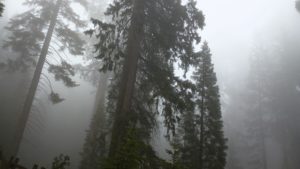I thought I would blog while I was vacation in California last week, but as Robert Burns said, “the best laid plans of mice and men often go awry.” Not surprising. Even as I always bring my computer on excursions, as well as a notebook and pen and good intentions, I rarely write anything more than a few answers to emails that can’t wait when I’m away. But I do find myself doing some of the internal work that goes with the territory of writing, particularly in how I’m drawn to setting. The wide expanse of central California’s landscape with its sandy foothills, waterfalls, and high peaks evoked both the wonder and unease I often feel visiting the west. While it seems humanly impossible not to be awed by the desert wilderness and the open sky, as an east coast girl with firm roots in New York City’s concrete, I always feel a bit unhinged in all that open space. Ultimately, I want the closed in comfort of narrow paths hedged by trees.
California has trees. But not the same canopy that you’d find on the east coast, especially in the area I visited: Yosemite and Kings Canyon/Sequoia National Parks. It takes a certain kind of courage to hug one of those giant sequoias, even for an intrepid tree-hugger like me. Much easier to plant a soft kiss and whisper sweet nothings to a thin sliver birch than to try to slide your arm around the girth of a sequoia and realize just how small you are in the universe. “These trees are like dinosaurs,” my husband quipped. “They don’t even seem like trees as much as like prehistoric beings.”
Calling these notable groves the Land of the Giants was not overrated marketing hype. It took a full seventeen seconds to scan all the way up to the top of one of these beauties and back down again to our little corner of the planet.
And that got me to thinking–what does it mean to look up?. To take a step away from the comfortable landscapes of our lives into the unknown, a question that was enforced metaphorically by the intense fog we drove through to reach the park.  Taking any creative risk is like driving through fog. We may not see the entire landscape of where we’re going in front of us; perhaps we can only see the vaguest contours, or a few inches of the road’s white line and a pair of headlights coming at us from the opposite direction, but we plod on ahead, focused only on what we can see, with the faith that if we keep going, the tops of the trees will slowly come into view.
Taking any creative risk is like driving through fog. We may not see the entire landscape of where we’re going in front of us; perhaps we can only see the vaguest contours, or a few inches of the road’s white line and a pair of headlights coming at us from the opposite direction, but we plod on ahead, focused only on what we can see, with the faith that if we keep going, the tops of the trees will slowly come into view.
To subscribe to this blog, sign up at ddinafriedman.substack.com
